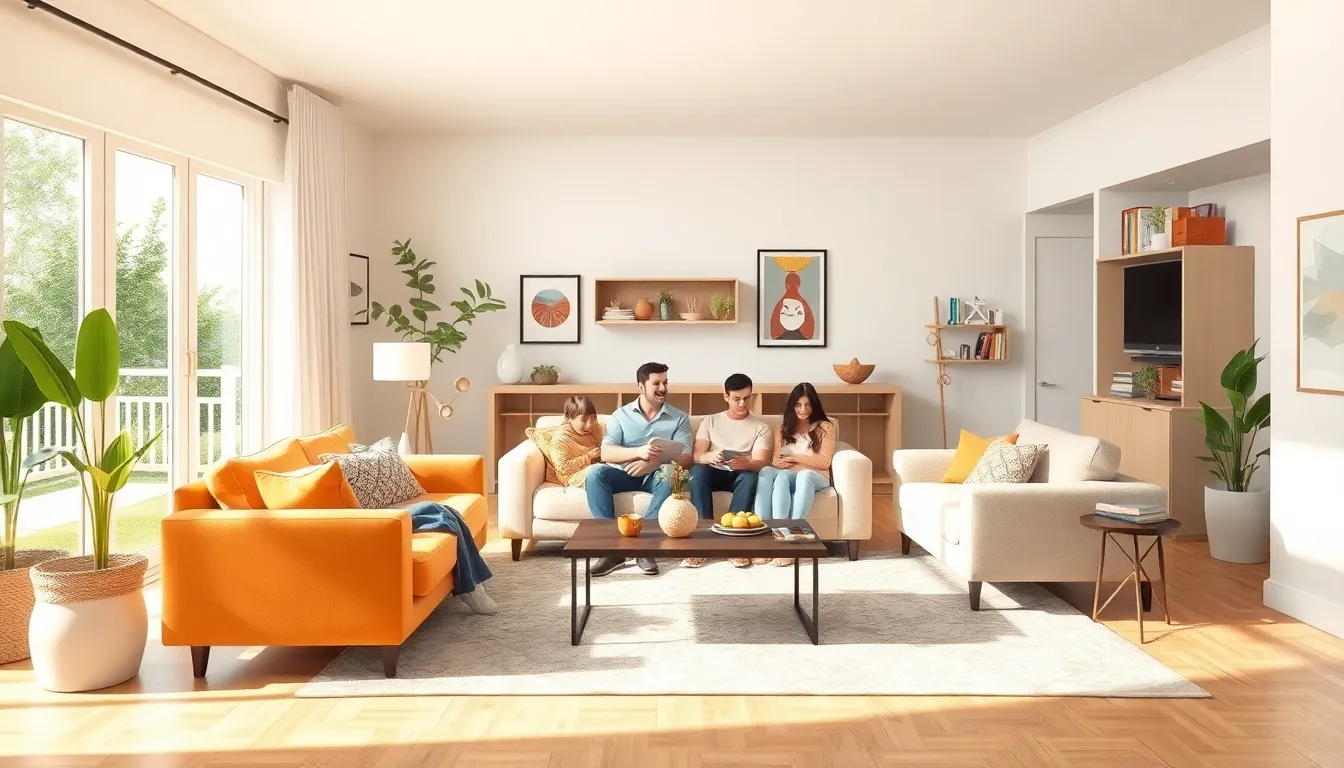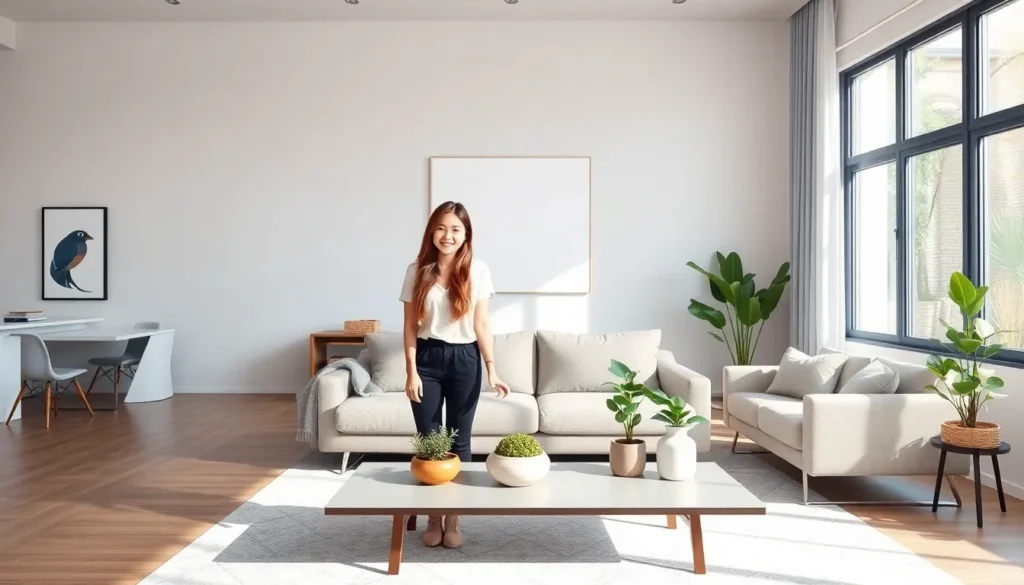Table of Contents
ToggleHome design is more than just slapping a coat of paint on the walls and calling it a day. It’s about creating a space that reflects personality and functionality. Whether you’re a minimalist at heart or a maximalist who believes more is merrier, there’s a design concept waiting to transform your home into a sanctuary.
What Are Home Design Concepts?
Home design concepts refer to the overarching ideas that guide the creation of living spaces. These concepts integrate aesthetics and functionality, ensuring that every element contributes to a cohesive atmosphere.
Various styles exist within home design, including modern, traditional, industrial, and contemporary. Each style brings unique characteristics, allowing individuals to express their personalities. Modern designs emphasize clean lines and a minimalist approach, while traditional designs often feature ornate details and rich colors.
Functionality plays a crucial role in home design concepts. Consideration of layout, flow, and usability optimizes space. For instance, open floor plans promote interaction and flexibility, making them popular among families.
Color palettes significantly influence the overall feel of a home. Neutral colors create a serene environment, while bold hues can energize a space. Choosing the right palette contributes to the desired ambiance.
Additionally, sustainable design concepts have gained popularity. Incorporating eco-friendly materials and energy-efficient systems fosters a healthier living environment. Homeowners increasingly value sustainability alongside style.
Incorporating technology also shapes modern home design. Smart home systems enhance convenience and security, reflecting contemporary needs. Integrating these technologies with design aesthetics ensures visual appeal remains intact.
Each home design concept fosters individuality and practicality. Understanding these concepts enables homeowners to create spaces that not only meet their needs but also reflect their unique tastes.
Key Elements of Home Design

Home design incorporates various crucial elements, including functionality and aesthetics. Each plays a significant role in creating an inviting and practical living space.
Functionality
Functionality focuses on how effectively a space meets daily needs. Space optimization enhances usability through thoughtful layout choices. Open floor plans promote interaction, making them ideal for families. Storage solutions, such as built-ins and multi-functional furniture, reduce clutter and maximize efficiency. Navigation within a home must be intuitive, ensuring smooth movement from room to room. Zoning areas for activities like cooking, relaxing, and working establishes a clear purpose for each space. Ease of access to essentials, such as appliances and furniture, boosts overall convenience and satisfaction.
Aesthetics
Aesthetics centers around visual appeal and personal expression. Color schemes set the tone, with neutral tones offering calm and bold colors adding energy. Lighting enhances ambiance, creating warmth or drama through different fixtures. Furniture selection complements style choices, whether modern or traditional. Textures, such as soft fabrics and sleek metals, create depth and interest in a room. Art and decorative elements add personality, reflecting the owner’s taste. Cohesion among design components results in a harmonious atmosphere, resulting in a space that feels both inviting and uniquely individual.
Types of Home Design Concepts
Home design encompasses various styles that reflect individual tastes, needs, and lifestyles. Here’s an overview of some prominent design concepts.
Modern Design
Modern design emphasizes simplicity and functionality. This style showcases clean lines, open spaces, and a lack of ornamentation. Furniture tends to be minimalistic, offering both comfort and visual appeal. Neutral color palettes often dominate modern spaces, with occasional bold accents to create interest. Incorporating natural materials like wood, glass, and metal enhances the aesthetic while promoting a connection with the environment. Adaptability is crucial, allowing homeowners to personalize their modern spaces to meet practical needs.
Minimalist Design
Minimalist design focuses on the principle of “less is more.” This aesthetic prioritizes essential elements, eliminating excess and clutter. Spaces are characterized by open floor plans, ample light, and functional furniture that serves multiple purposes. Typically, a monochromatic color scheme creates a calming atmosphere, with occasional color pops to add character. Storage solutions are cleverly integrated, maintaining the clean lines and sense of tranquility. Effective use of negative space contributes significantly to the overall visual impact and usability.
Rustic Design
Rustic design embraces natural materials and a cozy, inviting atmosphere. Wood, stone, and concrete are common elements, reflecting a strong connection to nature. Textures play a vital role, with woven fabrics and aged finishes adding warmth and character. Earthy color tones dominate rustic spaces, evoking a sense of comfort and relaxation. Antique or vintage furniture pieces often find their place, enhancing the charm of the design. This concept exudes a sense of nostalgia, appealing to those who appreciate traditional craftsmanship and organic aesthetics.
Tips for Implementing Home Design Concepts
Implementing home design concepts requires thoughtful planning and material selection. Homeowners can turn their visions into reality by paying attention to these key elements.
Planning Your Space
Start by assessing the layout and purpose of each area. Space should accommodate daily activities while fostering comfort. Identify zones for specific tasks, such as relaxing, dining, or working. Open floor plans promote interaction and maximize space usage. Focal points, like a fireplace or a stunning piece of art, capture attention and create a welcoming atmosphere. Circulation paths must remain clear, ensuring smooth movement throughout the home. Consider natural light, as it enhances mood and reduces energy costs. Incorporating these strategies results in a functional and inviting environment.
Choosing the Right Materials
Select materials based on aesthetics and practicality. Durable options, like hardwood or stone, offer longevity and visual appeal. Sustainable choices, such as bamboo or recycled materials, support environmental efforts. Use cohesive materials throughout the home to maintain a harmonious look. Textures also play a role; combining smooth and rough surfaces adds depth. When choosing colors, consider palettes that align with the overall design concept. Light shades can create a sense of spaciousness, while darker colors add intimacy. Prioritizing high-quality and appropriate materials leads to a beautiful, functional living space.
Home design is a powerful tool for transforming spaces into personal sanctuaries. By blending aesthetics with functionality, individuals can create environments that not only reflect their style but also meet their everyday needs. Embracing various design concepts allows for endless possibilities in crafting unique living spaces.
Whether opting for modern simplicity or rustic charm, the key lies in thoughtful planning and the selection of quality materials. As homeowners explore their design journeys, prioritizing comfort and usability will lead to harmonious atmospheres. With the right approach, anyone can achieve a home that’s both beautiful and practical.




